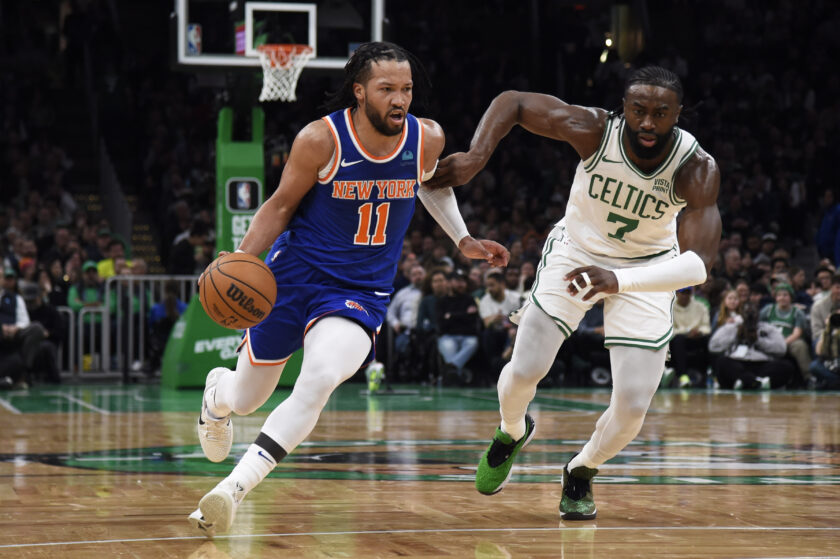New York Knicks draft profile: Stanford G Tyrell Terry

Tyrell Terry is an undersized point-guard with tantalizing skills on offense that needs to be on the New York Knicks’ radar.
[sc name=”geoffrey-campbell-banner” ]The New York Knicks have shooting and play-making at the top of their priority list. Tyrell Terry may not be a household name but he’s a talented shooter with great court vision.
Listed at 6-foot-1 and 160 pounds, the 19-year old Stanford freshman averaged 14.6 points per game, 4.5 rebounds per game, and just over three assists per game. Terry also shot 44.1% from the field, 40.8% from three-point range, and just under 90% from the line.
Despite an unconventional pre-draft Intell gathering process, Terry has impressed teams thus far. Per Bryan Kalbrosky of USA Today Sports, “According to a person who spoke to Rookie Wire on the condition of anonymity because they were not authorized to speak publicly on the matter, Tyrell Terry ‘broke a record’ for a basketball IQ test administered by several NBA front offices this offseason.”
Terry is likely to garner a lot of interest from NBA squads. Most mock drafts have him ranked outside of the lottery, and towards the middle/later parts of the first round. However, it’s possible that Terry’s draft stock will rise as we get closer to October. Let’s take a look at his strengths, weaknesses, and fit with the Knicks.
Strengths
Terry is a dynamic shooter. The Stanford freshman can pull it from deep with the best of them. He can shoot off the dribble and from a set position with relative ease.
Per Synergy, Terry shot within the 99th percentile in catch and shoot attempts in the half-court. He only shot within the 50th percentile in shots attempts off the dribble, but still ranked above Tyrese Haliburton, LaMelo Ball and just behind Tyrese Maxey and Devon Dotson in that area.
Terry’s shooting form, while it looks aesthetically appealing to the eye, has some unorthodox characteristics. Terry has his feet set very close together before bringing ball into his shot pocket. On some level, you would think this might affect his balance. Additionally, after his release, his feet appear staggered apart, similar to Jae Crowder. But despite all this, as it was the case during most of this season, the result was buckets!
As a play-maker, Terry ranks within the 77th percentile as a pick and roll ball handler in points per possession. In comparison with players in his draft class, Terry ranks higher than Tyrese Haliburton, Cole Anthony, Kira Lewis Jr, Killian Hayes, and LaMelo Ball. Terry has a knack for passing in tight spaces and is definitely able to find bigs rolling to the rim.
Terry’s vision and timing might be the most underrated parts of his game, but the numbers don’t necessarily back it up. The total amount of assists (99), and assist percentage (20.3) won’t jump out at you. In fact, Cole Anthony, who played in ten fewer games had 89 assists, and Devon Dotson (who is really more of a scoring guard) totaled 120 assists last season.
Still, as the videos below will show, when Terry is on the court, good things happen.
Finally, despite his diminutive stature, according to Hoop-Math.com, Terry finished 60.4% of his shots at the rim. For some context, he bested Cole Anthony (53.6%) and Kira Lewis Jr. (58.1%) in that category and wasn’t too far off from top picks from last year’s draft, RJ Barrett 64.4%, and Ja Morant 62.1%.
Weaknesses
Turnovers. For a lead guard Terry turned the ball over way too much last season. The freshman totaled 82 turnovers and had an abysmal assist-to-turnover ratio of 1.20. Terry played with a solid mix of upperclassmen in the rotation and Stanford was a well-coached team. As a result, Terry’s errors in play-making are most likely due to his age, size, and trying to do too much at times.
The first clip shows Terry losing his handle as he tries to split two defenders in a game versus Oregon. The second clip features a lazy cross-court pass after Terry received a pick in a loss against Kansas.
Not to harp on Terry’s size, but even if he had more weight, I think some of his defensive concerns would not be as significant. As it stands, the 160-pound guard gets lost on screens and has trouble finding his man at times. Furthermore, the lack of lateral foot speed hurts Terry when he’s trying to stay with opposing ball handlers.
In that same loss to Kansas, the first clip shows Terry struggling to get through screens to guard his man. Granted, he did initially help as Devon Dotson swung the ball to his teammate, but was still late getting to his man. In the second clip, Terry just gets absolutely torched by Dotson. It appears as though Terry never really gets into a good defensive stance, and has his hands up way too late.
Closing out to shooters and the occasional positional defensive awareness are also weaknesses for the Minnesota native. As a team and help defender Terry actually shows promise as he rotates with consistency and tags the roll man off the pick and roll.
Terry’s defensive rating (90.7) is not bad, but consider that Stanford was 16th in the nation in opponents points per game and 12th in team defensive rating. Playing with good defenders definitely helped to cover some of Terry’s shortcomings.
Terry’s level of focus is just not always there when it comes to guarding his man. Both clips, in a game versus Oregon, show Terry ball-watching, which led to two open three-point shots. The Cardinals ended up losing by 13, but the game was close late, and those six points could have made a difference.
Fit with the Knicks
Terry’s fit, based on skillset, with the Knicks, much less any team is not really an issue. The bigger questions are regarding his role and ceiling at the professional level. Even as an undersized guard, Terry’s shooting and play-making alone will make him a sought after talent.
However, if you’re looking for the Stephen Curry and Trae Young comparisons, neither are really not appropriate at this time. Terry has elements of his game that compare favorably, of course, this involves shooting, moving without the ball, and good court vision. However, the level of production is just not there to make comparisons to two of the NBA’s elite guards.
During his senior year at Davidson, Curry was tops in the nation in points, points per game, and win shares. During his freshman year at Oklahoma, Young was top five in both points and assists. Even Terry’s 447 points produced this past season pales in comparison to guards within his own draft class, Grant Riller (705) and Markus Howard (730).
Overall, Terry is an efficient shooter but he doesn’t have the volume of scoring or play-making to be considered a franchise level point guard…for now. If the Knicks considered, trading back (which I would not, unless you could somehow also get a lottery pick from a very loaded 2021 draft), Terry would definitely be a player to target. He’s a smart player who can make the game easier for Barrett, space the floor, and would have good chemistry with Mitchell Robinson.
Drafting Terry will come with a calculated risk, especially if a team wants him to be their starting point guard. But I’m willing to bet that his size won’t limit him too much at the professional level. Watching his tape and looking for clips of turnovers and examples of poor defense, I often, unintentionally, found clips of impressive passing and winning plays. With that alone, Terry has a place in the NBA.





